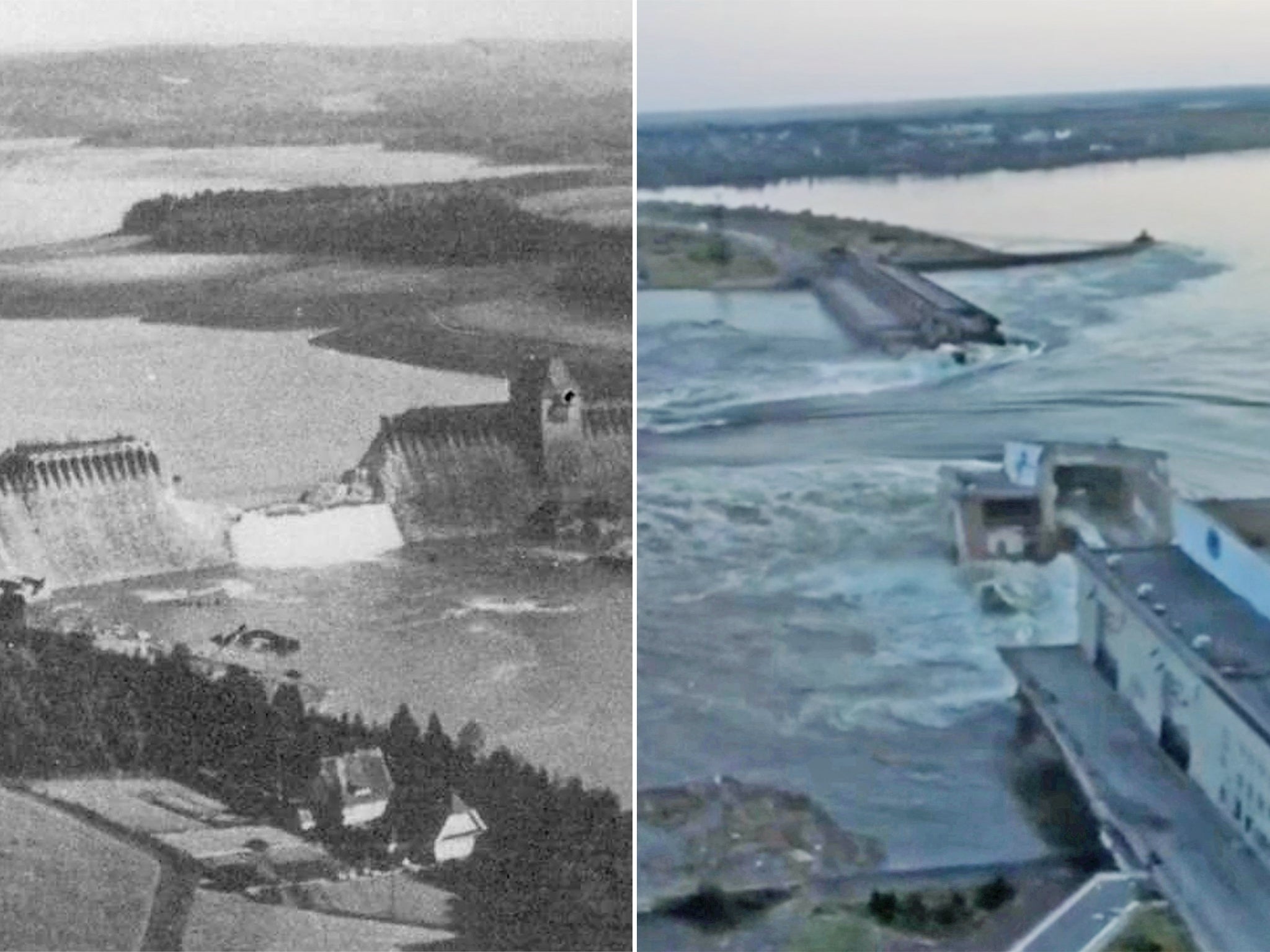From Stalin to Putin, dam-busting has been a barbaric and brutally effective tactic for warmongers for decades
The parallels between the destruction of the Nova Kakhovka dam on Tuesday and history’s most famous dambusting attacks are striking and shocking, writes historian Guy Walters


The order had come from the very highest level of the Kremlin. It was also brutally simple: blow up the dam. While it seemed desperate, there was no other way that the Russians were going to thwart what was likely to be an unstoppable enemy attack near the Dnieper River in south-eastern Ukraine. Demolition charges were duly placed by secret agents, and the ensuing explosion tore a massive breach out of the concrete structure. A huge surge of water gushed through, destroying numerous towns and settlements, and killing thousands.
The man who gave the order for this destruction was was not Vladimir Putin, but one of his predecessors – Josef Stalin. The date was August 1941, and the Soviet premier had ordered the demolition of the mighty Dnieper dam at Zaporizhzhia in order to slow down the advance of the Nazis. No matter that thousands of Ukrainians would perish, nor the horrific scale of ecological devastation.
The parallels between Stalin’s actions some eight decades ago and the destruction of the Nova Kakhovka dam on Tuesday are striking. While the Russians naturally deny their responsibility, Putin is the one with the most to gain.
As well as once more highlighting the barbarity of the Kremlin’s mindset, the breaching of the dam reminds us that the targeting of dams is a feature of warfare, and that we are likely to see such appalling events happen more frequently.
Dams are targeted in warfare for one – or a combination – of three simple reasons – to flood; to deny water supplies; to halt the production of hydroelectricity.
The most famous example of the third reason was of course the Dambusters raid carried out in May 1943 against three Germans dams that provided vital power for making steel. With two dams breached and another partially destroyed, the raid is often considered a huge success, and has indeed become a source of British national pride. What is often forgotten is that some 1,650 German civilians were drowned.
The destruction of the Nova Kakhovka dam is undoubtedly an example of the tactic of using flooding to hamper an enemy advance. In this, the Russians are following a long and brutal military tactic in modern warfare.
Such a manoeuvre was practised in autumn 1914 in Belgium during the First World War, when the Belgians found themselves in a parlous position on the Yser Front. On 25 October, the government gave its army permission to blow up dams and open the mighty canal locks at Nieuwpoort. The flood poured into the German positions, causing them to mount an impromptu attack, which was eventually repulsed and resulted in an Allied victory.
While in this instance the tactic was successful, there is a notorious example in which deliberately breaching dams both failed to stop the enemy and horrifically backfired.
It took place on 9 June 1938 during the Second Sino-Japanese War, when Chinese nationalists under the command of Chiang Kai-Shek blew up dams on the Yellow River in order to stop the Japanese advance. No warning was given by the Chinese army to its own population, and in the resulting flood of some 21,000 square miles, it is estimated that some 500,000 Chinese peasants were killed – while some estimates claim the figure is nearer to one million. Twelve million were made homeless, and ultimately, the Japanese advance was not halted.
Another example can be found in the current war in Ukraine, when, in March last year, the Russians were about to take the town of Moshchun, just north of Kyiv. By using pontoon bridges, Putin’s forces poured across the Irpin River, and the defenders were unable to stop them. It was then that the fateful decision was made by the Ukrainians to blow up a dam on the Kyiv reservoir, which immediately stopped the Russian advance, and enabled the Ukrainians to counterattack. The destruction of the dam went a long way towards saving Kyiv,
Because of the devastating consequences on the civilian population and the environment, the post-Second World War protocols of the Geneva Convention stipulate that attacks on dams should not take place ‘if such attack may cause the release of dangerous forces and consequent severe losses among the civilian population’. Therefore today, under the present Convention, the Dambusters Raid would be considered a war crime.
As recently as 2017, the Americans came extremely close to committing such a crime, when an US B-52 dropped three 2000lb bombs – including, according to The New York Times, one ‘bunker buster’ – on the Tabqa dam on the Euphrates in eastern Syria, which was being held by Isis fighters. The reason behind the bombing was given as "terrain denial". Thankfully, the bunker buster did not detonate, but had it done so and destroyed the dam, it is thought that the flood might have drowned hundreds of thousands of civilians. The Pentagon defended the strike, saying it was only intended to destroy the dam’s control towers and that "analysis had confirmed that strikes on the towers attached to the dam were not considered likely to cause structural damage to the Tabqa Dam itself".
For its part, IS also used dams as a weapon of war, but rather than using flooding, it sometimes used dams to deny water. After it had seized the Ramadi dam on the Euphrates in Iraq in May 2015, IS operated the dam to reduce the flow on the river by a half, thereby denying water to at least four governate areas. Isis was also happy to close dams to cause areas upstream to flood, as it did in 2014 in order to try to flood the area around Fallujah in an effort to dislodge Iraqi troops besieging IS forces in the city.
There is perhaps a fourth reason why armies breach dams, and that is out of murderous spite, in a variant of Hitler’s "scorched earth" policy that might be labelled "sodden earth". In January 1993, retreating Serbian-Yugoslav forces tried to destroy the Peruca Dam in Croatia in order to flood the valley below and kill thousands of Croatians. Fortunately, the attempt failed.
What we have seen this week in Kakhovka is likely to happen again, not least because Putin has tried breaching dams in Ukraine before. On 26 February last year, the Ukrainians reported that they had intercepted a Russian missile that was heading for a dam near Kyiv, which, had it been breached, would have flooded the entire left bank of the city.
It is therefore chilling to think that there are 1053 remaining reservoirs in Ukraine, each of which has its own dam, all of which are vulnerable to an attack. Be warned – Kakhovka may just be the beginning of a flood.
Guy Walters is a historian, who can currently be seen on the Netflix series ‘How to Become a Tyrant’






Join our commenting forum
Join thought-provoking conversations, follow other Independent readers and see their replies
Comments